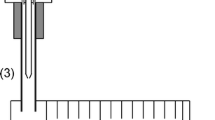Abstract
Laser-based ion mobility (IM) spectrometry was used for the detection of neuroleptics and PAH. A gas chromatograph was connected to the IM spectrometer in order to investigate compounds with low vapour pressure. The substances were ionized by resonant two-photon ionization at the wavelengths λ = 213 and 266 nm and pulse energies between 50 and 300 μJ. Ion mobilities, linear ranges, limits of detection and response factors are reported. Limits of detection for the substances are in the range of 1–50 fmol. Additionally, the mechanism of laser ionization at atmospheric pressure was investigated. First, the primary product ions were determined by a laser-based time-of-flight mass spectrometer with effusive sample introduction. Then, a combination of a laser-based IM spectrometer and an ion trap mass spectrometer was developed and characterized to elucidate secondary ion–molecule reactions that can occur at atmospheric pressure. Some substances, namely naphthalene, anthracene, promazine and thioridazine, could be detected as primary ions (radical cations), while other substances, in particular acridine, phenothiazine and chlorprothixene, are detected as secondary ions (protonated molecules). The results are interpreted on the basis of quantum chemical calculations, and an ionization mechanism is proposed.













Similar content being viewed by others
References
Eiceman GA, Karpas Z (2005) Ion mobility spectrometry. CRC Press, Boca Raton
Borsdorf H, Mayer T, Zarejousheghani M, Eiceman GA (2011) Recent developments in ion mobility spectrometry. Appl Spectrosc Rev 46:472–521
Borsdorf H, Eiceman GA (2006) Ion mobility spectrometry: principles and applications. Appl Spectrosc Rev 41:323–375
Lubman DM, Kronick MN (1983) Multiwavelength-selective ionization of organic compounds in an ion mobility spectrometer. Anal Chem 55:867–873
Gormally J, Phillips J (1991) The performance of an ion mobility spectrometer for use with laser ionization. Int J Mass Spectrom Ion Proc 107:441–451
Headrick JM, Reichardt TA, Settersten TB, Bambha RP, Kliner DAV (2010) Application of laser photofragmentation-resonance enhanced multiphoton ionization to ion mobility spectrometry. Appl Optics 49:2204–2214
Kotkovskii GE, Martynov IL, Novikova VV, Chistyakov AA (2009) A laser ion-mobility spectrometer. Instrum Exp Tech 52:253–259
Löhmannsröben H-G, Beitz T, Laudien R, Schultze R (2004) Laser-based ion mobility spectrometry for sensing of aromatic compounds. Proc SPIE 5547:16–24
Oberhüttinger C, Langmeier A, Oberpriller H, Kessler M, Goebel J, Müller G (2009) Hydrocarbon detection using laser ion mobility spectrometry. Int J Ion Mobil Spec 12:23–32
Gillig KJ, Ruotolo B, Stone EG, Russell DH (2000) Coupling high-pressure MALDI with ion mobility/orthogonal time-of-flight mass spectrometry. Anal Chem 72:3965–3971
Beitz T, Laudien R, Löhmannsröben H-G, Kallies B (2006) Ion mobility spectrometric investigation of aromatic cations in the gas phase. J Phys Chem A 110:3514–3520
Junger M, Bodeker B, Baumbach JI (2010) Peak assignment in multi-capillary column-ion mobility spectrometry using comparative studies with gas chromatography–mass spectrometry for VOC analysis. Anal Bioanal Chem 396:471–482
Hill HH, St Louis RH, Morrissey MA, Shumate CB, Siems WF, McMinn DG (1992) A detection method for unified chromatography. J High Res Chromat 15:417–422
Frisch MJ et al (2009) Gaussian 09, Revision A.02. Gaussian, Inc., Wallingford
Eiceman GA, Nazarov EG, Stone JA (2003) Chemical standards in ion mobility spectrometry. Anal Chim Acta 493:185–194
Eiceman GA, Vandiver VJ, Leasure CS, Anderson GK, Tiee JJ, Danen WC (1986) Effects of laser beam parameters in laser ion mobility spectrometry. Anal Chem 58:1690–1695
Borsdorf H, Eiceman GA (2006) Ion mobility spectrometry: principles and applications. Appl Spectr Rev 41:323–375
Compendium of analytical nomenclature, edited by HMN H Irving, H Freiser and TS West, Pergamon, Oxford, 1978; 2nd edition, edited by H Freiser and GH Nancollas, Blackwell Scientific Publications, 1987; 3rd edition, edited by J Inczedy, Blackwell Scientific Publications, 1998
Hanley L, Zimmermann R (2009) Light and molecular ions: the emergence of vacuum UV single-photon ionization in MS. Anal Chem 81:4174–4182
Rink JE, Boesl U (2003) Mass-selected resonance-enhanced multiphoton ionisation spectra of laser-desorbed molecules for environmental analysis: 16 representative polycyclic aromatic compounds. Eur J Mass Spectrom 9:23–32
Clowers BH, Hill HH (2005) Mass analysis of mobility-selected ion populations using dual gate, ion mobility, quadrupole ion trap mass spectrometry. Anal Chem 77:5877–5885
Schwarz L (2007) Dissertation, Humboldt-Universität zu Berlin, Sierke Verlag, Göttingen
Tang X, Bruce JE, Hill HH (2007) Design and performance of an atmospheric pressure ion mobility Fourier transform ion cyclotron resonance mass spectrometer. Rapid Commun Mass Spectrom 21:1115–1122
NIST Chemistry WebBook, http://webbook.nist.gov/chemistry/. Accessed 11 Oct 2012
Boesl U (1991) Multiphoton excitation and mass-selective ion detection for neutral and ion spectroscopy. J Phys Chem 95:2949–2962
Gross JH (2004) Mass spectrometry. Springer, Berlin
Acknowledgments
The authors are grateful for the financial support from the BMBF and the administrative support from the PT Jülich within the framework of the ForMaT II project (FKZ: 03FO1042).
Author information
Authors and Affiliations
Corresponding author
Additional information
Published in the topical collection Photo Ionisation in Mass Spectrometry with guest editor Ralf Zimmermann.
Rights and permissions
About this article
Cite this article
Brendler, C., Riebe, D., Ritschel, T. et al. Investigation of neuroleptics and other aromatic compounds by laser-based ion mobility mass spectrometry. Anal Bioanal Chem 405, 7019–7029 (2013). https://doi.org/10.1007/s00216-012-6654-7
Received:
Revised:
Accepted:
Published:
Issue Date:
DOI: https://doi.org/10.1007/s00216-012-6654-7




